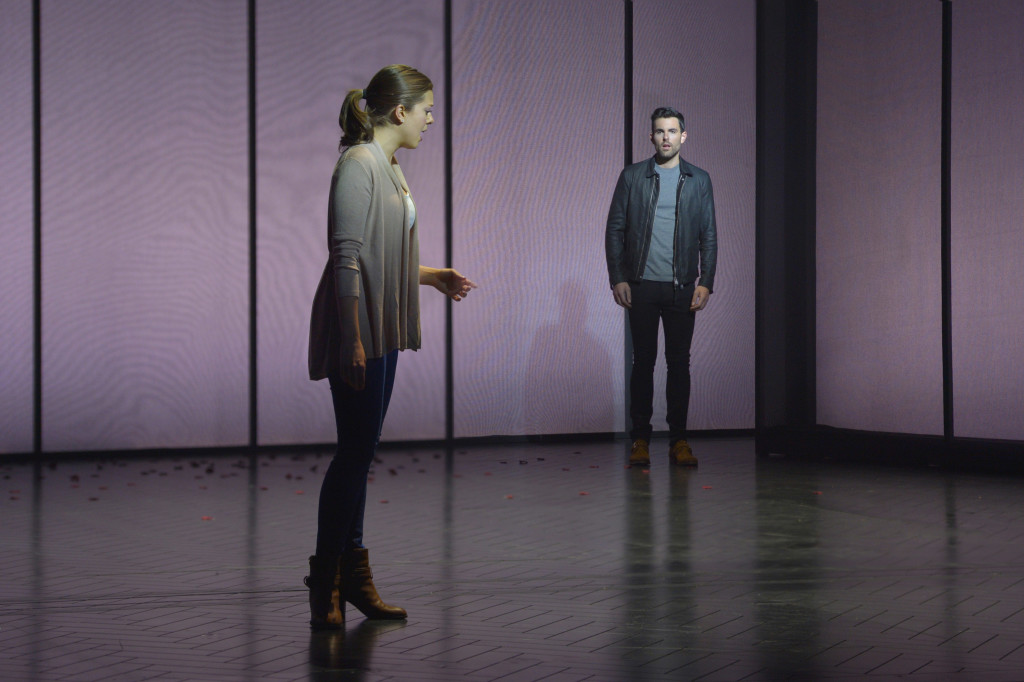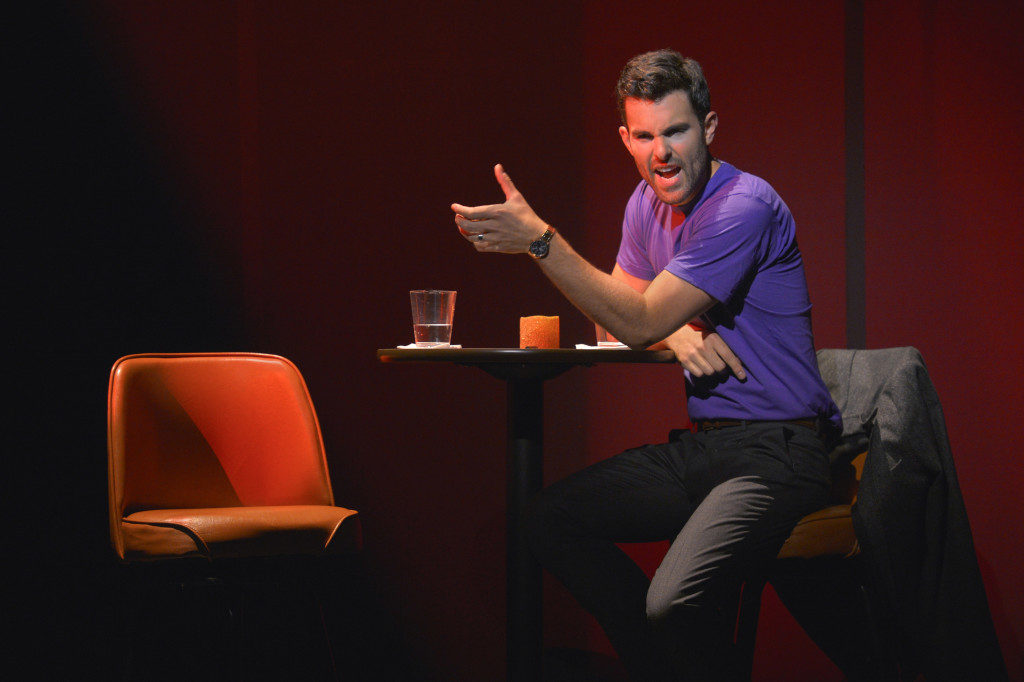
Cathy (Margo Seibert) bids Jamie (Zak Resnick) goodbye after their first date. At the same time, Jamie says goodbye to their relationship in Jason Robert Brown’s acclaimed musical, The Last Five Years, now playing through June 5 at American Conservatory Theater’s Geary Theater.
The Last Five Years is a musical that lands perfectly between conventional musical theater’s necessary suspension of disbelief and good theater’s necessary emotional connection to the audience. In theater, I don’t really need to believe what I’m seeing and hearing if I believe what I’m feeling, a quality that the American Conservatory Theater’s ongoing production of The Last Five Years embodies in a way that the movie adaptation never could (or should have attempted). Jason Robert Brown, the writer and composer, is a master of complementing—his music complements his characters, his writing complements his settings, and his tone complements his personal and modern approach to musical theater. At The Geary Theater, the A.C.T.’s team production and Michael Berresse’s direction complement the integrity and idiosyncrasies in Brown’s work, in which Cathy and Jamie separately tell their love story in alternating songs in chronological (Jamie starts at their first kiss) and reverse (Cathy starts at their break-up) orders.
Tim Mackabee and Robert Wierzel, the respective scenic and lighting designers, represent a special kind of genius. Upon entering the theater, the most noticeable set piece is an enormous modern floral wreath that hangs from the stage ceiling at an upward tilt on its downstage side. Its monotone whiteness continually provides interesting and stark lighting reflections and shadows throughout the performance, and its circularity is somehow comforting—like it will somehow keep Cathy and Jamie’s love safe. But the true brilliance in the set design lies in the stage wide box that remains a constant presence. Four transparent walls bordered with black framing start off in a traditional box shape, but at different points the walls slide open, turn to other angles, and are tinted in vibrant colors or blacked into complete obscurity. A musical that operates in dynamic space and time needs a set that can support and emphasize such spatial and temporal nonlinearity, while mirroring the simplicity of a show that usually has one actor in a plainclothes costume onstage. This central set piece and its integration with the lighting, as well as automated smaller scenes (a dock, a kitchen table set with changing details like flowers, a worn armchair and bookshelf) that slide in from stage right and left, are what The Last Five Years needs for its surreal and real elements to mesh believably. Like the story and the music, it is multi-dimensional.

Cathy (Margo Seibert) floats on air after deciding to movie in with Jamie in Jason Robert Brown’s acclaimed musical, The Last Five Years, now playing through June 5 at American Conservatory Theater’s Geary Theater.
But an audience cannot connect to metaphoric scenery and nonlinear narrative without emotionally convincing and resonant storytelling. This comes from Zak Resnick and Margo Seibert’s embodiment of everything Jamie and Cathy need to be: theatrical singers, complex actors, huge stage presences, and real people. It is Michael Berresse’s direction that connects the actors’ talents with Brown’s words with Mackabee and Wierzel’s designs. In some moments, his choices feel forced and cheesy. When the actors engage in too many “interactions” with their absent partner, the effect teeters on pantomime. Some attempts to strengthen thematic moments are also overdone. During “Still Hurting”, Cathy takes off her watch as she sings the word “time”, the same watch that Jamie produces from under the Christmas tree (adorned with a Star of David) when he sings “time” during “The Schmuel Song.” Watches tell time, this musical plays with time, we understand. But the majority of similar staging decisions create more subtlety and “aha” reactions. Also during “The Schmuel Song,” Jamie sings the line “Cathy Hyatt, big time star!” on downstage left. Over on stage right, Cathy stands upstage of the furthest back set wall with her back to the audience as she opens her arms in a Broadway solo moment. These are the kinds of brilliant choices that create beautiful visual parallels as the narrative goes in different directions. Often, the non-performing character comes on stage, almost obscured and unnoticed, and mirrors the singing character’s gestures or movements for a few seconds. And then they’re gone.
These moments establish Berresse’s strong choreographic vision that comes to a head during the approximately 15 total minutes the characters spend on stage together and aware of each other. In “The Next Ten Minutes” and “Goodbye Until Tomorrow/I Could Never Rescue You”, the careful use of space and physical transitions make Cathy and Jamie’s togetherness all the more poignant. They come from opposite diagonals and meet center stage, they imitate and replace each other’s paths and end positions, and they meet from opposite downstage sides, turn up and walk upstage center in parallel, and turn back away from each other in the direction they come from, exiting the stage, and each other’s lives, for good. Their wedding dance is particularly breathtaking, especially in contrast to how much time they spend alone onstage. You cannot dance without another person physically there to hold and keep time with. But all their onstage movements and blocking translate as a dance in the way that they extend the narratives, character development, and emotions occurring in the text and music.

After being hit on by another woman, Jamie (Zak Resnick) fights panic and feelings of inevitability in Jason Robert Brown’s acclaimed musical, The Last Five Years, now playing through June 5 at American Conservatory Theater’s Geary Theater.
I thought that maybe this would be the first production of The Last Five Years I would get through without shedding a tear; I was wrong. But as Berresse concludes his interview in Words on Plays, “If you’re feeling, you’re alive.” Though whether the characters are equally sympathetic, slight problems with gender roles and stereotypes, and the bias of Brown’s personal experience as the inspiration for the show remain eyebrow-raisers and nagging questions after any rendition of The Last Five Years, this one ultimately succeeds—it elicits feeling through depicting real life and stirs aliveness through shaking real emotions. The A.C.T. production extends this impact through the performance’s casting, lighting, set, directing, and blocking. When the production elements become steeped with the already rich emotions in a show’s music, story, and structure, the audience cannot help but to also absorb it, feel it, and live it.
